The future is brighter than ever with AI as a Service! This revolutionary technology is opening up a world of possibilities for businesses of all sizes. Finally, advanced artificial intelligence is accessible to all - no PhD required!
Leading AIAAS providers are democratizing AI, empowering innovators and dreamers to create intelligent solutions. With easy-to-integrate APIs and SDKs, you can infuse any application with the power of AI in no time.
Imagine chatbots that delight your customers, predictive insights that turbocharge decisions, and new efficiencies that boost the bottom line. This is the promise of AIAAS. It's easy, flexible, and cost-effective - the perfect recipe for AI success!
But it gets even better. Major players like AWS, Microsoft Azure, and Google Cloud bring robust AI toolkits to the table. So you're in good hands. With the right AIAAS partner, implementing AI is a breeze.
Ready to transform your business? This guide explains everything you need to know. Learn how AIAAS works, key benefits and use cases, implementation best practices, and more. So, read on…
What is AI as a Service (AIAAS)?

AI as a Service (AIAAS) refers to providing artificial intelligence capabilities through cloud-based services.
This enables businesses to access advanced AI technologies without requiring extensive infrastructure investment.
This section will explore how AI as a Service works and discuss its key components.
How AI as a Service Works?
AI as a Service uses cloud-based resources to deliver AI capabilities to users. It involves utilizing AI algorithms and models, data storage and processing, and integrating existing systems.
Developers can easily incorporate AI functionalities into their applications through application programming interfaces (APIs) and software development kits (SDKs) offered by AIAAS providers.
Key Components of AI as a Service
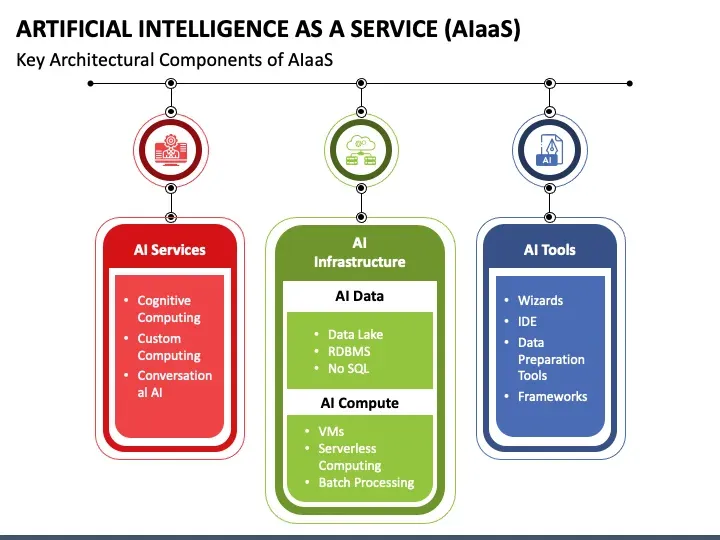
Cloud-based AI Services: Artificial intelligence as a service providers offer a range of AI services through the cloud, including machine learning, natural language processing, computer vision, and more. These pre-built services allow businesses to leverage advanced AI capabilities without in-house expertise or infrastructure.
APIs and SDKs: AIAAS providers offer APIs and SDKs that enable developers to integrate AI functionalities into their applications easily. These tools provide access to pre-trained models, allowing developers to tap into complex AI algorithms and leverage them in their solutions.
Data Storage and Processing: AIAAS relies on cloud-based storage and processing capabilities to handle large volumes of data required for AI tasks. By storing data in the cloud, businesses can access it anytime and ensure it is readily available for training AI models and performing real-time inference.
Integration with Existing Systems: Artificial intelligence as a service solutions are designed to integrate seamlessly with existing systems and workflows, allowing businesses to use AI capabilities without disrupting their operations. This integration facilitates the adoption of AI as a complementary tool that enhances existing processes and decision-making.
Benefits of AI as a Service
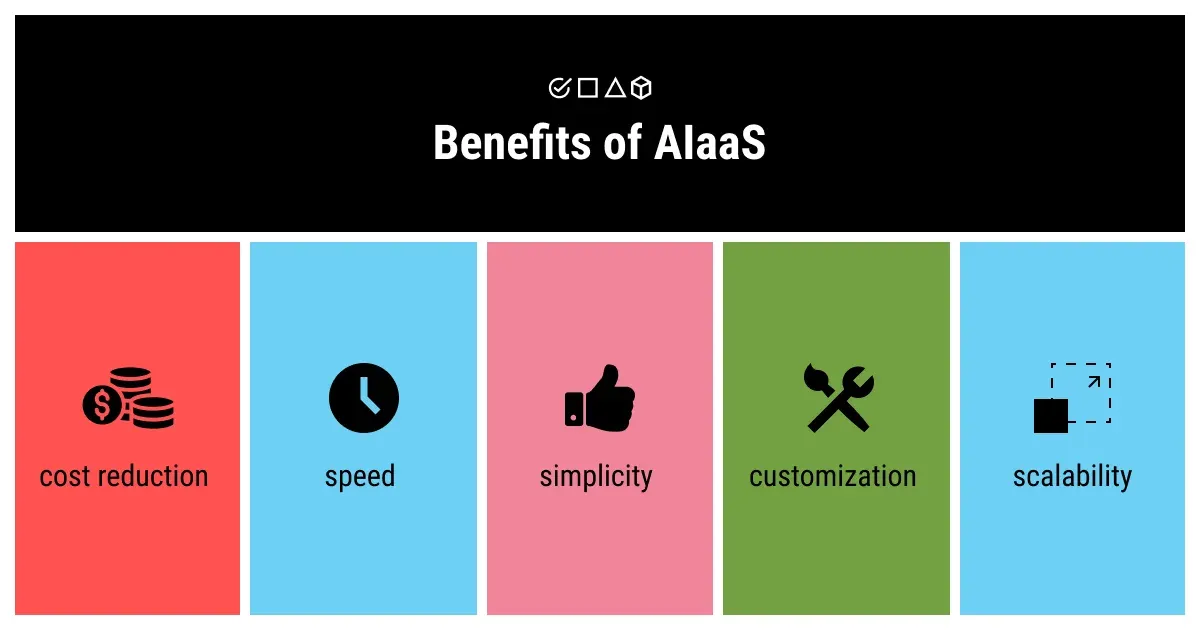
One of the main advantages of AI as a Service is that it provides businesses with access to advanced AI technologies without the need for extensive infrastructure investment.
This section explores the key benefits of AIAAS.
Access to advanced AI technologies without heavy infrastructure investment
AIAAS enables businesses of all sizes to leverage advanced AI capabilities through cloud-based services. By removing the need for extensive infrastructure investment and in-house AI expertise, AIAAS allows companies to tap into the transformative potential of AI at a fraction of the cost.
Scalability and flexibility: Artificial intelligence as a service allows businesses to scale their AI capabilities up or down as needed, depending on their requirements. This flexibility means organizations can use AI services without being locked into fixed costs.
Reduced time and cost in AI development: AIAAS providers offer pre-built AI services, pre-trained models, and APIs that enable rapid development and deployment of AI solutions. This significantly reduces the time and cost of building AI models from scratch, allowing businesses to focus on their core competencies and gain a competitive edge.
Next, we will cover some common applications of AI as a Service.
Suggested Reading:
Common Applications of AIAAS
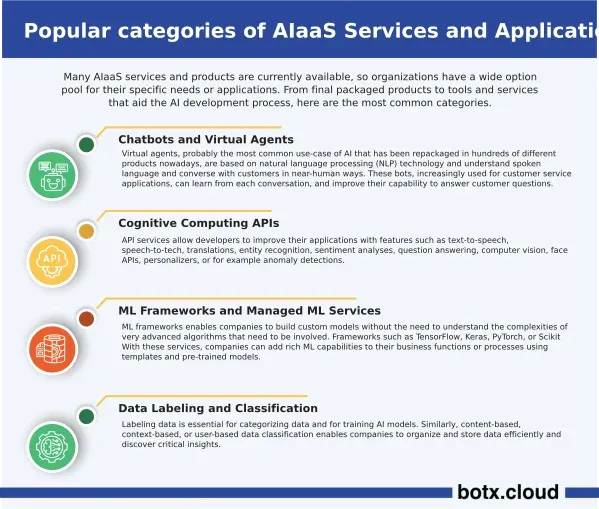
AIAAS is applied to various business use cases to enhance efficiency, innovation, and customer experience.
Here are some of the most common applications of Artificial intelligence as a service
Chatbots and virtual assistants: AIAAS enables the development of intelligent chatbots that can mimic human conversation and respond to customer queries in real time. These chatbots can help businesses improve customer service, reduce wait times, and increase customer satisfaction.
Predictive analytics: AIAAS uses machine learning algorithms to analyze massive amounts of data in real time. This enables businesses to generate more accurate forecasts and make data-driven decisions faster.
Image and speech recognition: AIAAS allows businesses to develop solutions that leverage image and speech recognition technologies. These capabilities are widely used in industries such as e-commerce, healthcare, education, and automotive.
Natural language processing: AIAAS enables the development of natural language processing (NLP) capabilities, which allows computers to understand and analyze human language. Applications of NLP include sentiment analysis, text classification, and chatbot development.
Next, we will cover some key players in the AI as a Service market.
Key Players in the AIAAS Market
AI as a Service (AIAAS) is gaining popularity as organizations seek to leverage the power of artificial intelligence without the need for extensive investments in infrastructure and expertise.
Several providers have emerged to cater to this growing demand. In this section, we will explore some of the prominent players in the AIAAS market and highlight their offerings.
BotPenguin
BotPenguin is a leading AIAAS provider that offers a comprehensive range of AI solutions. The platform enables businesses to automate customer interactions through chatbots and virtual assistants.
With its intuitive interface and pre-built templates, BotPenguin allows even non-technical users to create and deploy AI-powered chatbots for platforms like:
- WhatsApp Chatbot
- Facebook Chatbot
- WordPress Chatbot
- Telegram Chatbot
- Website Chatbot
- Squarespace Chatbot
- woocommerce Chatbot
- Instagram Chatbot
Amazon Web Services (AWS)
AWS is a dominant player in the cloud computing market and provides a range of AI services through its AWS AI suite. These services include image and video analysis, language processing, and machine learning tools.
With its scalable infrastructure and extensive AI capabilities, AWS empowers businesses to develop and deploy sophisticated AI models.
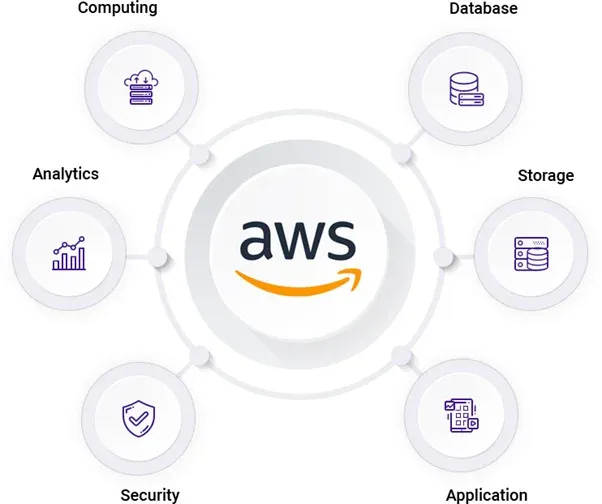
Google Cloud Platform (GCP)
GCP offers various AI services that enable developers to build intelligent applications. Their AI offerings include natural language processing, speech recognition, and image analysis.
GCP's AI solutions are renowned for their accuracy and scalability, thanks to Google's expertise in machine learning and data analytics.
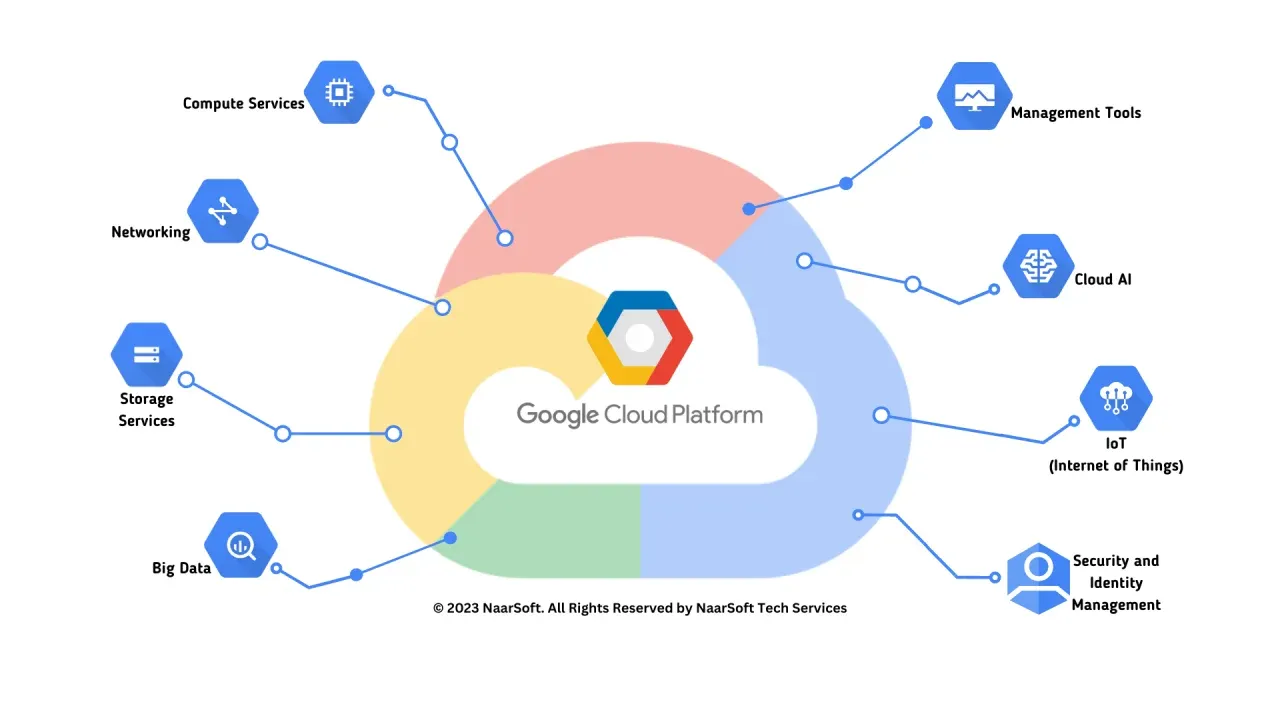
Microsoft Azure
Microsoft Azure provides a comprehensive suite of AI services, making it an attractive choice for businesses adopting AI technologies. Azure offers pre-built models for various use cases such as computer vision, language understanding, and anomaly detection.
Additionally, Azure's AutoML feature allows users to build custom machine learning models without deep AI expertise.
After looking into the market, next we will cover how to implement AI as a Service.

AIAAS Implementation Process
Now that we have explored the key players in the AIAAS market, let's take a closer look at the implementation process for AI as a Service.
Implementing AI in your organization involves several vital steps:
Defining AI use cases and requirements
Identify the areas or tasks where AI can bring the most value to your business. Determine the goals, desired outcomes, and potential challenges. This step ensures that AI implementation aligns with your business objectives.
Choosing the right AIAAS provider
Evaluate the offerings of different Artificial intelligence as a service providers based on cost, scalability, flexibility, and ease of use. Consider the specific requirements of your use cases and select a provider that best matches your needs.
Data preparation and cleaning
This step involves gathering, organizing, and cleansing the data for AI model development. High-quality data is crucial for accurate AI predictions, so ensure the data is representative, comprehensive, and free from biases.
Model development and training
Use the selected AIAAS provider's tools to develop and train your AI models. This may involve feeding the cleaned data into the platform and configuring the desired algorithms and parameters. The provider's platform should offer easy-to-use interfaces and robust capabilities for model development.
Deployment and monitoring
Once the AI model is trained, it must be deployed and integrated into your business processes. Monitor the model's performance and make necessary adjustments to optimize its effectiveness. Continuous monitoring helps ensure the AI system performs accurately and stays current with changing business requirements.
Everything has two sides, positive and negative, so let us see some of the challenges of AI as a Service.
Suggested Reading:
Challenges in AIAAS Adoption
Adopting AI as a Service (AIAAS) brings numerous benefits to organizations, but it is not without its challenges.
In this section, we will explore some of the key challenges businesses may face when implementing Artificial intelligence as a service solutions and how they can overcome them.
Data privacy and security concerns
AIAAS relies heavily on data, and organizations must ensure that the data they share with service providers is protected. Concerns about data privacy, compliance with regulations, and the risk of data breaches are common.
To address these concerns, it is crucial to carefully evaluate the security measures implemented by AIAAS providers, including encryption, access control, and data anonymization techniques.
Vendor lock-in
When organizations adopt AIAAS solutions, they depend on the specific provider's infrastructure and APIs. Switching to a different provider can be challenging, leading to vendor lock-in.
To mitigate this risk, businesses should consider using standardized APIs and formats, ensuring that their data and models can be easily migrated to alternative platforms if needed.
Continuous monitoring and maintenance
Artificial intelligence as a service solutions require ongoing monitoring and maintenance to ensure their performance and accuracy. Models may need to be updated, retrained, or fine-tuned with new data.
Additionally, monitoring is essential to detect any anomalies or biases arising over time. Establishing clear processes for monitoring and maintenance is crucial to maximizing the impact of AIAAS investments.
Ethical considerations in AI usage
AI has the potential to significantly impact society, raising ethical concerns. AIAAS solutions must adhere to ethical guidelines to avoid biased or discriminatory outcomes.
Organizations must ensure that their use of AI aligns with legal and ethical standards, including fairness, transparency, and accountability. It is essential to regularly assess the ethical implications of AI usage and address potential biases.
As challenges are everywhere, solutions are available, so we will cover how to address these challenges next.
Addressing the Challenges
Overcoming the challenges of AIAAS adoption requires proactive measures and strategic considerations.
Here are some actions organizations can take:
Thoroughly assess AIAAS providers
Before choosing an AIAAS provider, thoroughly evaluate its data security measures, compliance frameworks, and privacy protection track record.
Understand their policies for data handling, access, and retention to ensure they align with your organization's requirements and industry regulations.
Plan for flexibility and interoperability
When implementing AIAAS solutions, prioritize platforms that offer standardized APIs and integration options.
This allows for greater flexibility and reduces the risk of vendor lock-in, as it facilitates the migration of data and models to alternative platforms.
Establish monitoring and maintenance practices
Develop robust processes for monitoring the performance of AI models deployed via AIAAS. Implement regular reviews and audits to identify and rectify any biases or inaccuracies.
Consider establishing dedicated teams or roles responsible for ongoing monitoring, retraining, and maintenance.
Embrace ethical AI practices
Educate your teams about the ethical implications of AI usage and establish clear guidelines for AI development and deployment. Consider implementing algorithms and processes that promote fairness, transparency, and accountability. Regularly review and update your ethical practices to ensure compliance with evolving ethical standards.
By addressing these challenges head-on, organizations can successfully navigate the adoption of AIAAS and harness AI's full potential to drive innovation, efficiency, and growth while ensuring data security, ethical usage, and long-term sustainability.
Next, we will cover future of AI as a Service.
Future of AIAAS
As AI as a Service (AIAAS) continues to evolve, it presents several exciting future trends and business opportunities.
In this section, we will explore some key areas where we can expect to see advancements and how they can create new organizational possibilities.
Future Trends and Opportunities in AIAAS
Continued advancements in AI technologies: AI technologies are evolving rapidly, and we can expect continuous advancements in the capabilities of Artificial intelligence as a service solutions. Machine learning algorithms, natural language processing, computer vision, and deep learning techniques are increasingly sophisticated. These advancements will enable AIAAS providers to offer more accurate and context-aware AI services, opening up opportunities for organizations to leverage AI in more complex and diverse use cases.
Integration with Internet of Things (IoT): The integration of AIAAS with the Internet of Things (IoT) presents immense potential. By combining AI capabilities with IoT data from connected devices, businesses can gain real-time insights, automate processes, and enable intelligent decision-making. AIAAS can analyze and process the vast amounts of data generated by IoT devices, extracting actionable insights and driving operational efficiencies across various industries, such as manufacturing, healthcare, and transportation.
Personalization and customization of AI services: AIAAS providers are increasingly focusing on personalization and customization of AI services. By understanding user preferences, behavior, and context, AI models can deliver more tailored and relevant experiences. Personalized recommendations, intelligent chatbots, and virtual assistants that learn and adapt to individual user needs are some examples of the opportunities presented by personalized AIAAS solutions. This trend enables businesses to enhance customer satisfaction, engagement, and loyalty.
AI democratization and accessibility: As AIAAS solutions improve and become more accessible, we can expect a greater democratization of AI. AIAAS platforms are designed to cater to users with varying levels of technical expertise, enabling non-technical users to leverage AI technologies effectively. This democratization of AI allows businesses of all sizes to harness the benefits of AI without the need for extensive in-house AI expertise or infrastructure, thereby leveling the playing field and creating new opportunities for innovation and growth.
Seizing the Future Opportunities
To take advantage of the future trends and opportunities in AIAAS, organizations should consider the following actions:
Stay abreast of AI advancements: Continuously monitor advancements in AI technologies and keep updated with the latest capabilities offered by AIAAS providers. Understanding the potential applications and limitations of these technologies will help organizations identify areas where AI can bring the most value and plan for future implementation.
Explore IoT integration: Investigate how IoT devices and data can be integrated with AIAAS solutions to drive real-time insights, process automation, and intelligent decision-making. Identify specific use cases within your organization where IoT and AI can deliver value, such as predictive maintenance, smart asset tracking, or automated anomaly detection.
Leverage personalization and customization: Embrace AIAAS platforms that offer personalization and customization capabilities, and explore how they can be applied to enhance customer experiences, deliver tailored recommendations, or automate personalized interactions. By understanding your customers' preferences and needs, you can provide more engaging and targeted services, ultimately improving customer satisfaction and loyalty.
Embrace AI democratization: Evaluate AIAAS providers that cater to non-technical users, allowing your organization to leverage AI regardless of its technical expertise. Such platforms provide intuitive interfaces, pre-built models, and automation tools that simplify AI implementation, enabling small and medium-sized enterprises to access the benefits of AI without significant investments in infrastructure or AI expertise.
By keeping a pulse on future trends, exploring the integration of IoT and AI, embracing personalization and customization, and leveraging AI democratization, organizations can position themselves to capitalize on the opportunities presented by AIAAS and drive innovation, efficiency, and competitive advantage in the AI-powered future.
Conclusion
The future is here. AI as a Service opens infinite possibilities, allowing us all to tap into intelligence once reserved for tech titans.
Soon, AI will be embedded in every facet of business and life. The playing field is leveled. Anyone can innovate.
Yet realizing this full potential requires finding the right partner skilled at making AI accessible. This is where BotPenguin shines.
With its intuitive chatbots and virtual assistants powered by advanced artificial intelligence, BotPenguin makes it easy for any business to automate customer interactions, boost productivity, and work smarter.
No AI expertise is needed - simply integrate BotPenguin's APIs into your systems and processes to inject enterprise-grade intelligence.
Let BotPenguin's powerful and user-friendly AI solutions take your business into the future by enhancing operations, delighting customers, and unlocking sustainable growth.
The time to embrace AI is now. Visit www.botpenguin.com and unlock your potential. The future awaits.
Suggested Reading:
Frequently Asked Questions (FAQs)
What is AI as a Service (AIAAS), and how does it differ from traditional AI?
AI as a Service (AIAAS) refers to cloud-based AI solutions, providing on-demand access to machine learning capabilities. Unlike traditional AI, AIAAS allows users to utilize AI tools and algorithms without requiring extensive in-house infrastructure.
What are the key benefits of adopting AIAAS in business operations?
AIAAS offers scalability, cost-effectiveness, and accessibility to advanced AI technologies, empowering businesses to integrate machine learning into their processes. It enhances efficiency, accelerates innovation, and reduces the barriers to AI implementation.
How can AIAAS be applied across different industries?
AIAAS finds applications in diverse sectors, such as healthcare, finance, and manufacturing. It can be utilized for predictive analytics, natural language processing, image recognition, and other tasks, revolutionizing processes and decision-making in various domains.
Can small businesses benefit from AIAAS, or is it more suitable for larger enterprises?
AIAAS is beneficial for businesses of all sizes. Its scalable nature allows small businesses to access and leverage AI capabilities without significant upfront investments, fostering innovation and competitiveness in a rapidly evolving market.
How does AIAAS contribute to reducing the time and cost of AI projects?
AIAAS eliminates the need for organizations to build and maintain complex AI infrastructure. By providing readily available AI resources on a pay-as-you-go model, it significantly reduces the time and cost associated with developing and deploying AI projects.


